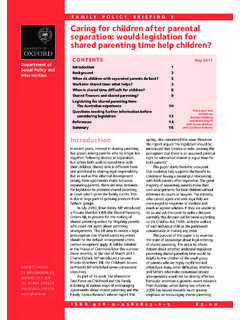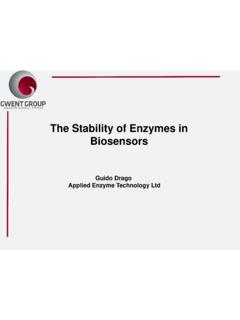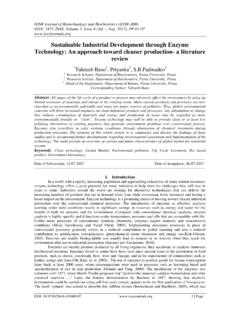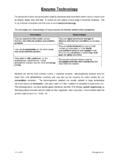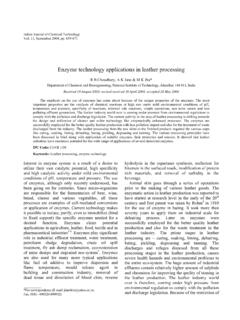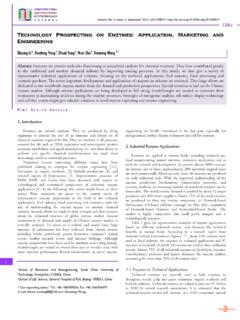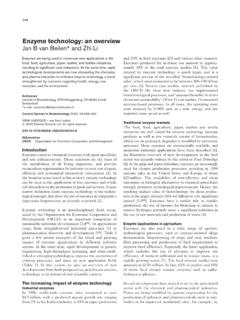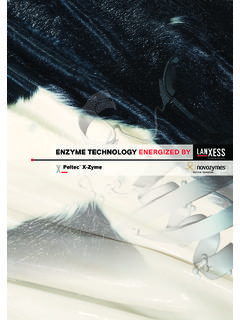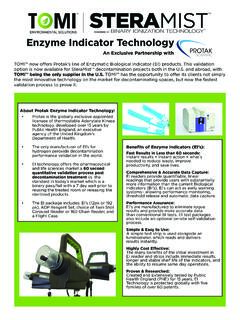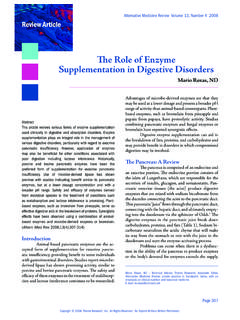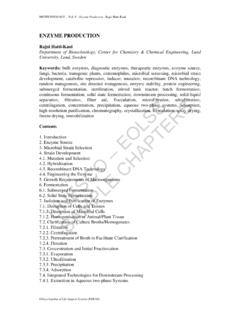Transcription of 21 Enzyme technology - Nuffield Foundation
1 Advanced applied science: GCE A2 UNITS. The Nuffield Foundation 2008. ACTIVITY BRIEF. Enzyme technology The science at work enzymes enzymes have become big business. They are used in many industrial processes to catalyse biological reactions. enzymes are exploited in a variety of manufacturing processes such as food processing and for the synthesis of medicines such as antibiotics like artificial penicillin. They are also used to clean up factory effluents and pollution in water and soil. Many processes can be made faster and cheaper by using the right Enzyme and conditions. Optimum conditions are maintained during factory production by use of bioreactors. These are vessels which are designed to provide the ideal environment for reactions involving enzymes or living organisms. Your brief Most people in the UK produce an Enzyme called lactase in their small intestine to break down lactose, the sugar found in milk.
2 However, many people do not produce enough lactase and therefore have problems digesting the milk. They may get diarrhoea, wind and stomach cramps if they consume milk or milk products. This is caused by the action of bacteria in the gut, fermenting the lactose. This problem has been addressed by a number of companies who produce lactose free milk. Such companies have to address the problem of establishing the optimum conditions for their milk treatment process. Task 1 Investigating the use of a bioreactor Your task is to make a bioreactor containing an immobilised Enzyme and use it to produce lactose reduced milk. You will assess the effect that temperature has on the Enzyme driven reaction within the bioreactor. Use Study sheet: Investigating a bioreactor Task 2 Using Bioreactors You will make a detailed report of the findings of your investigation and relate them to the use of Enzyme technology and bioreactors in industry.
3 Use Study sheet: Using bioreactors Enzyme technology : page 1 of 10. advanced applied science: GCE A2 UNITS. The Nuffield Foundation 2008. STUDY SHEET. Investigating a bioreactor Introduction Simple bioreactors can be constructed in the laboratory, using basic apparatus. These can be used to study the feasibility of processes and to establish the most favourable reaction conditions. The most promising processes can then be trialled using more sophisticated equipment. Eventually pilot studies yield the information that scientists and engineers need to be able to take the expensive step of designing and building chemical manufacturing plant on an industrial scale. In this task, you design, carry out and write up an experimental test of a bioreactor. In the next task, you will be asked to write a report to discuss your results in relation to industrial practice.
4 The experiment Lactose reduced milk can be made by using a bioreactor to treat skimmed milk with immobilised lactase Enzyme . Using the information provided and other sources, design and carry out a practical investigation of the effect of temperature on the activity of the Enzyme lactase, when immobilised and used in a bioreactor. Summary You will need to: 1 Write a clear plan of action of your own to include: the method/procedure to be followed, with measurements of appropriate precision, repeated when appropriate a list of equipment and reagents, with quantities and concentrations timing and laboratory/other requirements detailed risk assessments consistent with COSHH guidelines, using secondary sources an explanation of the use of a range of techniques and equipment. 2 Obtain data: working with appropriate accuracy using appropriate precision making a detailed set of relevant observations collecting sufficient data to complete simple statistics.
5 3 Display and analyse the data accurately: using a range of methods illustrating trends clearly. 4 Draw simple conclusions: basing them solely on your data and observations relating them to your tables, charts and/or calculations. Enzyme technology : page 2 of 10. advanced applied science: GCE A2 UNITS. The Nuffield Foundation 2008. Doing it 1 Agree a time scale with your teacher. You must work to a deadline, but establish how much class time you will have. 2 Carry out research and decide on a suitable method. Use Fact sheet: Bioreactor techniques and other suitable resources to help you. 3 Write a provisional plan in outline and have it approved by your teacher. Use the Summary to check what you need to include. This first draft need not be in detail, just establish that you have chosen a workable safe method. 4 After you have consulted your teacher, modify or develop your plan.
6 It would be a good idea to plan a short pilot study to test your chosen methods and establish the quantities and concentrations of the materials that you need. Include: requests for materials and resources risk assessments planned times for supervised laboratory work. Health and safety: Do not undertake any practical work until you have had your plans agreed by your teacher. Before carrying out any practical work a risk assessment must be carried out. Wear eye protection. Some people are allergic to lactase solution; avoid getting it on your skin or rubbing eyes after handling. Wash your hands before and after your practical work. 5 Carry out your investigation. You may need to repeat some things or modify your approach as you go along. Continue to submit revised plans as necessary and do not undertake any work without prior approval. Keep a record of all the work that you do as evidence of your planning, including any rough notes and references to sources that you use (paper, electronic or human).
7 6 It is good practice to plot results in a graph or calculate averages as you go along, so you can see if results are reliable. If you have inconsistent or anomalous results, you should repeat measurements and parts of procedures to check for possible causes of errors and to get more accurate results. Make notes of any relevant observations. 7 Complete the analysis of your data and write a report of your investigation to meet the criteria shown in the Summary. Include: introduction method results conclusions. Do not include a detailed discussion of your findings. You will do this in your next task. Enzyme technology : page 3 of 10. advanced applied science: GCE A2 UNITS. The Nuffield Foundation 2008. FACT SHEET. Bioreactor techniques Lactose reduced milk can be made by using a bioreactor to treat skimmed milk with immobilised lactase Enzyme .
8 The following techniques may be modified for investigating this process. Technique 1: Immobilising an Enzyme enzymes may be immobilised using calcium alginate beads. 1 Mix 10 cm3 of 2% sodium alginate solution and cm3 of lactase solution in a small beaker (use a syringe or pipette to measure out the solutions). Mix well trying to avoid creating too many air bubbles. 2 Place 100 cm3 w/v calcium chloride solution into a clean beaker. 3 Draw up the sodium alginate and lactase mixture into a disposable pipette or syringe and add it drop by drop to the calcium chloride. Hold the tip of the pipette or syringe about 5 cm above the surface, adding the mixture slowly as a steady stream of drops. Make sure the pipette or syringe doesn't touch the calcium chloride. Alginate beads will form in the solution. Try to make as many as possible, then leave them for about 5 minutes to harden.
9 4 Sieve off the alginate beads from the calcium chloride solution with the tea strainer. 5 Rinse the beads with distilled water. 6 If necessary, beads may be stored under water in a refrigerator overnight. Technique 2: Construction of a simple bioreactor 1 Take an empty syringe barrel or a separating/dropping funnel and put a piece of gauze in the bottom. A small piece of net curtain or glass wool [handle with forceps] may also be used. If using a syringe, attach a piece of plastic tubing to the nozzle and close it with a screw clip. Fix your apparatus on a clamp stand. 2 Add the beads to fill the syringe or funnel and gently tap them down. 3 If you wish, you may insulate the body of the bioreactor. Technique 3: Processing with a bioreactor 1 Use a water bath to heat samples of the substrate solution to be processed. Leave long enough to reach the desired temperature (varies).
10 enzymes have different optimum operating temperatures. Immobilised enzymes are more thermostable than those in solutions. 2 For continuous flow processing the tap or screw clip is left open. Substrate solution at a given temperature is poured or pumped into the body of the bioreactor so that it flows through the alginate beads and is collected using the tube at the bottom. The flow rate may be adjusted by partially opening or closing the screw clip or tap. Enzyme technology : page 4 of 10. advanced applied science: GCE A2 UNITS. The Nuffield Foundation 2008. 3 For batch processing, close the tap and add enough distilled water to the bioreactor to cover the alginate beads. Run this off into a measuring cylinder and record the volume. This indicates the volume of substrate that may be processed in one batch in the bioreactor. Add enough substrate solution to the column/body of the bioreactor to cover the alginate beads.


